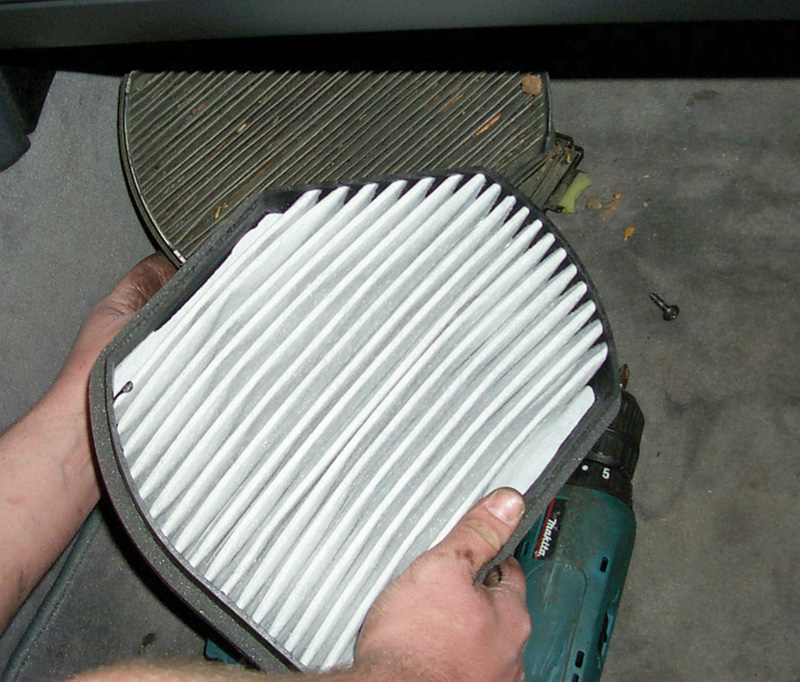Cabin Filters
 Current Mercedes-Benz models use cabin filters, sometimes two in series, to clean the incoming air to the passenger compartment. When there are two cabin filters, the first is an electrostatic particulate filter to catch dust and pollen, and the second is an activated charcoal filter to remove vapors. Each vehicle owner’s manual lists the corresponding replacement interval, though under particularly dusty (or malodorous) conditions it may be advisable to replace them after a shorter interval.
Current Mercedes-Benz models use cabin filters, sometimes two in series, to clean the incoming air to the passenger compartment. When there are two cabin filters, the first is an electrostatic particulate filter to catch dust and pollen, and the second is an activated charcoal filter to remove vapors. Each vehicle owner’s manual lists the corresponding replacement interval, though under particularly dusty (or malodorous) conditions it may be advisable to replace them after a shorter interval.
Failure to replace the filters can reduce the volume of fresh air drawn into the car. In extreme cases, it could even contribute to the overheat-failure of the blower motor since that is cooled by the incoming air.
Models 129 and 124 carry the dust filter under the hood. Model 140 has both dust and charcoal filters under the hood, and some 140s require drawing a vacuum on the rubber bead around the filter to extract it from the housing. Model 202 has a dust filter under the dash, and the 210 and 220 have both filters under the dash. Model 208 has a combination dust/charcoal filter under the dash. Model 203 has a dust filter under the hood and a charcoal filter under the dash.
Replace the electrostatic dust filters every 15,000 miles on 1997 and older cars. The change interval goes to 25,000 miles for 1998 and later. Charcoal filters should be replaced every 45,000 miles up to 1997 and every 60,000 after that.
Batteries
 It’s neither convenient nor economical to wait until failure before replacing a battery. But there are more factors in selecting a battery for a car than the size of the case and orientation of the positive and negative terminals. The extent of the warranty generally corresponds to the overall quality of the battery, but the performance specifications are the most critical details. The only performance specifications to use for comparison are CCA and RC. CCA (cold cranking amps), defined by the Battery Council International as “the number of amps a lead-acid battery at 0°F (-17.8°C) can deliver for 30 seconds and maintain at least 1.2 volts per cell†(7.2 volts for a 12-volt lead-acid battery), reflects the battery’s ability to start an engine under low-temperature conditions. RC (reserve capacity), BCI defined as “the number of minutes a new, fully-charged battery at 80°F (27°C) can be discharged at 25 amps and maintain a voltage equal to or higher than 1.75 volts per cell†(10.5 volts for a 12-volt battery), represents the time the battery will continue to operate essential accessories in the event of a charging system failure.
It’s neither convenient nor economical to wait until failure before replacing a battery. But there are more factors in selecting a battery for a car than the size of the case and orientation of the positive and negative terminals. The extent of the warranty generally corresponds to the overall quality of the battery, but the performance specifications are the most critical details. The only performance specifications to use for comparison are CCA and RC. CCA (cold cranking amps), defined by the Battery Council International as “the number of amps a lead-acid battery at 0°F (-17.8°C) can deliver for 30 seconds and maintain at least 1.2 volts per cell†(7.2 volts for a 12-volt lead-acid battery), reflects the battery’s ability to start an engine under low-temperature conditions. RC (reserve capacity), BCI defined as “the number of minutes a new, fully-charged battery at 80°F (27°C) can be discharged at 25 amps and maintain a voltage equal to or higher than 1.75 volts per cell†(10.5 volts for a 12-volt battery), represents the time the battery will continue to operate essential accessories in the event of a charging system failure.
Â






0 Comments